Wajuru
- Self-denomination
- Where they are How many
- RO 248 (Siasi/Sesai, 2014)
- Linguistic family
- Tupari
Since time immemorial the Wajuru have lived in a rich multiethnic context, regularly exchanging spouses, blood, music and all kinds of knowledge with other peoples whose social configurations depend on this interaction. Known as the most warrior-like people among the other neighbouring indigenous groups, the Wajuru are also famous for welcoming visitors and identifying themselves as a ‘hard-working’ people and consumers of chicha, a fermented drink produced by women.
The Wajuru name and peoples
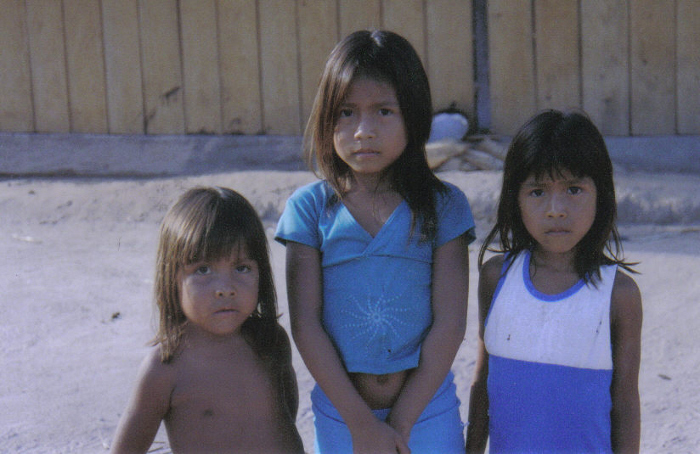
Today the people use the terms Wayurú, Ayurú, Wajuru or Ajuru to refer to themselves. The first two names are frequently employed to indicate older people born during the ‘maloca era’ when whites were absent or merely present on the margins of their world. The third and fourth terms are related more closely to the present and a life in which white people have become continually and irrevocably present.
In the past the Wajuru were divided into three distinct groups. Today’s population represents the historical merging of these peoples: 1) the Guayurú, the Rock People, conceived to be the true or real Wajuru, also known by the term Wãnun mian (wãnun meaning ‘rock’); 2) the Agouti People, Wakuñaniat; 3) and the Forest People, Kündiriat. These groups form a single unit from the linguistic viewpoint, but separate groups from the viewpoint of their territorial origin and their ways of life.
The suffix iat functions as a ‘collectivizer’ used to refer to other collectivities identified by the speaker and linked more to various categories of others, including spirits and affines. This distinction is primarily made from the viewpoint of the Guayurú (the true Wajuru) and their direct descendents. Hence the expression Wajuru iat may be used by someone identifying themselves as Wajuru, but has an odd or amusing connotation. Wakuñaiat and Kündiriat, on the other hand, are used without reserve.
The Guayurú (true Wajuru) or Wãnun mian (Rock People) refer to people who lived close to a rocky mountain range, a region that sheltered the spirits of their dead. As they say: We’re from the rocks! While the Guayurú are seen as the Rock People – identified with the land they once occupied – the Agouti, Wakuñaiat, are identified with a lazy people who raided other peoples’ swiddens rather than work themselves. They are like agoutis. Durafogo Opeitxá, a very old Wajuru shaman, is the only living representative of this people and during the chichadas [chicha festivals] all the older people jokingly call him Agouti. Finally the Kündiriat were a forest dwelling people who wandered freely, never building malocas or cultivating swiddens. For this reason they are seen to come from a ‘civilization inferior’ to that of the true Wajuru. Those belonging to the Kündiriat people are always Other, especially living elders or those who have already died.
The multiplicity of peoples encompassed by the ethnonym Wajuru derives from linguistic and territorial differences considered to be primordial. These are anchored in mythic narratives on the first times. The Wajuru mythological corpus, containing themes very similar to those found among various neighbouring peoples, announces and deepens these differences: after humans were encountered below the earth by the demiurgical brothers and left this subterranean world, two events provoked their subsequent sociological differences. In the first event, all the humans were seated when the younger, more reckless brother began to speak various languages and taught a different one to each person: Wajuru, Tupari, Jabuti, Makurap and so on, including the language of the whites – already present at the beginning of time. This generated enormous confusion and misunderstanding among them. The second event took place after the younger brother thought of death and thereby conjured it into existence. The emergence of death marks the moment when people, no longer seated, began to walk on the earth, guided by the discoverer brothers. From then on each group was identified with a specific place, which became their territory.
After this time these peoples no longer mixed or formed tribes, the Wajuru say. Guayurú, Kundiriat and Wakuñaiat were then given a single linguistic identity, simply Wajuru, ‘the same’ people from the viewpoint of the first event. On the other hand they are different in terms of their primordial territoriality since it was after the second event that people began to walk on the earth. It is also said that had Wakowereb, the younger demiurge, not given a language to the whites, they would not be so numerous as they would simply not exist – since the linguistic distinction leads to distinctions between types of people – and the Wajuru would today be the largest population on Earth. But because of this ‘confusion,’ the Wajuru are now very few in number, a fact which they resent.
Another distinction exists, based on the transformations in forms of social organization. This distinction is between the Guayurú, Kündiriat or Wakuñaniat (peoples from the maloca era, who did not mix among themselves or marry with other groups) and the Wajuru, above all descendents of the true Wajuru who mixed with other peoples. The latter classification seems to be fairly contemporary since it emphasizes the exogamic context (marriages between people from distinct ethnic groups) in which the Wajuru and other peoples originating from the middle Guaporé river live today.
Location
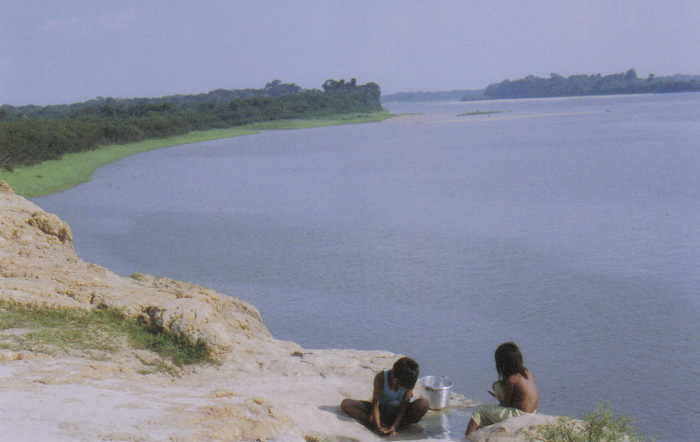
In the first decades of the 20th century the Wajuru were located by explorers and rubber extractors on the Terebito and Colorado rivers, affluents of the right shore of the middle Guaporé river, in the state of Rondônia. Most of the village-based population, around 90 people (in 2009), lives in the Rio Guaporé Indigenous Territory, located on the lower Guaporé. This demarcated area is also occupied by many other peoples (Makurap, Djeromitxí, Tupari, Arikapu, Aruá, Aikanã, Kanoê and Kujubim), the total population of the IT in 2009 exceeding 600 people. Another important demographic cluster lives in Porto Rolim de Moura do Guaporé, a settlement on the shores of the Mequéns river, composed of Wajuru women, their husbands and children.
Language
The Wajuru language was classified by the linguist Aryon Dall’Igna Rodrigues as a member of the Tupi linguistic trunk and the Tupari family. The older Wajuru frequently speak more than one indigenous language. The younger members of the group are mostly passive speakers of the Wajuru language and fluent speakers of Portuguese. Some understand more than one indigenous language but speak Portuguese only, which seems to be the reality experienced by the majority of young people from the area. Occupying a region on the international border, many people also speak Spanish well. To give an example of this multilingualism, the oldest child of the couple Pororoca Wajuru and Pacoreiru Djerotmitxí speaks Wajuru, Jabuti and Portuguese, as well as understanding Makurap and Tupari, while their younger children speak Jabuti and have some proficiency in Wajuru, as well as being completely fluent in Portuguese. Portuguese has been adopted as a lingua franca between the groups and today occupies the place previously occupied by the Makurap language in the middle Guaporé region. In the domestic sphere it is common for people to use the mother or father’s language in addition to Portuguese. Hence the younger couples, even though communicating largely in Portuguese, have various linguistic possibilities. However women are recognized as the grouping with the most ‘expanded’ linguistic range, since they commonly understand more than two or three languages. This derives from the fact that they reside with their husband’s domestic group, who typically speak another language.
Contact history
The peoples living on the affluents of the right bank of the Guaporé river, especially those located on the shores of the Branco, Terebito and Colorado rivers, remained ‘unknown’ until the beginning of the 20th century. In 1914 there were reports in the region from the explorations made by the English Major P. H. Fawcett, who later rose to the rank of Colonel. At the time of his trip a rubber extraction area had already been set up on the Colorado river. It was only in the 1930s that some researchers produced rough maps of the traditional territory of these peoples: Snethlage in 1936 and 1937, followed later by Becker-Donner & Caspar in 1955.
Events in the nearby areas in the 19th century, shortly prior to this period, are little documented. At a broader level, historiography records a low level of trade and a still lukewarm demand for rubber, which began to be explored more systematically in Amazonia in the second half of the 19th century, especially from 1880 onwards. This was the start of a period of exploration that intensified until the first decade of the 20th century, a period when around 100,000 workers – most of them from Brazil’s northeast – were sent to the Amazonian region to work as rubber tappers. The year 1912 marks the beginning of a drastic reduction in production due to Asian competition, followed thirty years later by a notable rise due to the Second World War.
However, in relation to the region of the right shore of the middle Guaporé, there was an interesting fact worth noting: the rubber tappers arrived during the rubber industry’s period of decline. It was only in 1912 that a German founded a rubber tapper settlement on the Colorado river, which put the Wajuru, Makurap and later the Djeoromitxí and Aruá in contact with foreigners (Price 1981). It was the establishment of the Pernambuco seringal (rubber extraction area), followed by the development of the São Luís seringal between 1910 and 1920 on the upper Branco river, which catalyzed the process of contact with indigenous peoples in the headwater regions of these rivers (Maldi 1991). These rubber companies drastically incorporated the region’s indigenous populations into their workforce, as well as being responsible for the countless measles epidemics that struck most of the region’s indigenous peoples. In 1927, the US-based Guaporé Rubber Company set up a seringal in Paulo Saldanha on the Branco river (Price 1981).
In the 1950s Caspar (1956) observed that although marriages among the peoples of the right bank of the middle Guaporé river seemed to be a long-standing practice (as early as 1934, Snethlage had encountered two Tupari women living among the Arikapú), they were also interested in forming alliances with non-Indians, at the time widely present in the region. The author also states that this disposition towards alliances with whites, transforming them into sons-in-law or brothers-in-law, was responsible for the increase in marriages among ‘friendly’ groups. According to this interpretation, the location of the Makurap, Djeoromitxí and Aruá on the navigable parts of the Branco river led to them being the first to suffer from the desperate search for women by the rubber tappers, forcing these peoples to look in turn for potential spouses among the Arikapú and Wajuru. Likewise, the low number of marriable women caused by the arrival of the rubber tappers forced some Arikapú, Wajuru and Makurap men to look for women among the Tupari. The non-Indians therefore entered a pre-existing system of multiethnic exchanges, speeding up and increasing these exchanges.
According to Maldi (1991), at the start of the second half of the 20th century all the seringals in the region of the Branco, Colorado, São Luís, Laranjal and Paulo Saldanha rivers were acquired by João Rivoredo, an officer with the former SPI (Indian Protection Service) who thereby became the sole owner of all the seringals. João Rivoredo is held responsible for a series of barbaric acts: dissolution of all the indigenous villages in the region and subjection of the Indians to poor health conditions, causing many deaths. These actions were reflected in the actions of the agency for which he worked, whose policy involved, as well as attraction and transference of the Indians to Indigenous Posts, their recruitment in the seringals.
In 1930, in the same period when rubber exploration was increasing in the middle Guaporé region, the SPI created the Ricardo Franco Indigenous Attraction Post on the river’s lower course, which later became the Rio Guaporé Indigenous Area. The first demarcation of this area dates from 1935 and received approval from Field Marshal Rondon. Its history is no different from the history of other SPI posts, created with the objective of ‘civilizing’ the Indians. Neither was the area spared the epidemics that decimated indigenous peoples in interfluvial regions. Its ‘peak’ as an agricultural colony was in the 1940s when SPI employees compulsorily transferred the indigenous peoples of the Mequéns, Colorado and Corumbiara rivers and their affluents to the area (FUNAI 1985). There are records indicating that the Wajuru, who until then had inhabited the inland forest between the Colorado and Branco rivers, were transferred to the Post between the 1940s and 50s: “In 1947 70 Makurap were transferred to the Ricardo Franco Post, having been recently contacted at the Pedro de Toledo IP (Rio Apidiá), along with 70 Ajuru and Jaboti” (SPI: Rec. 554/1947 and Rec. 559/1947, FUNAI 1985).
Another history
A number of different peoples on the middle Guaporé played an important role in the process of contact between the whites and the groups living in areas located further away from the main river courses. Responses to these new contacts varied considerably and depended on the degree of bellicosity of the indigenous groups concerned.
According to the elder shaman Antônio Côco, many Wajuru were living in the malocas on Preto creek, on the upper course of the Terebito river, when they saw white people for the first time. Accompanied by Arikapú Indians already familiar to them and a Wajuru elder, the expedition – composed of three explorers – was greeted in the Wajuru malocas in the form in which other humans or kin should be welcomed: they gave them chicha, maize, yams and peanuts along with meat. They received the visitors as though they already knew them, ‘taming them.’ The Wajuru were not frightened and quickly became used to the new visitors: they already knew they were people, though different from them since their language was different and so too their food. These non-Indians became known as the ‘Tabô’ by the Wajuru, since they arrived, embraced and said: ‘Tá bom?’ (‘How are you?’) ‘Tabô.’
The Arikapú also established peaceful relations with the whites and it was from them that the Wajuru obtained their first metal axes. Invited to accompany them in the exploration of the region, some Wajuru headed to the Jaboti maloca along with the Arikapú. The warlike Djeoromitxí wanted to attack to the whites. For the true Wajuru, this was a clear demonstration of the incapacity of the Djeoromitxí to recognize the humanity of potential allies. But it was not only the Djeoromitxí who resisted the first contacts: the Kündiriat (one of the Wajuru peoples) also did so and are remembered as those who took a long while to be tamed, in contrast to the true Wajuru.
There are few Wajuru accounts of their journeys to the Pernambuco seringal, making it difficult to ascertain whether the first non-Indians reached their malocas before or after the establishment of this seringal. It is also uncertain whether the Wajuru came across the Pernambuco seringal before the whites found their own malocas.
Advised by other Indians of the manufactured goods available at the Pernambuco seringal, Sinamú, the Wajuru leader at the time, visited the seringal on a number of occasions. There he left Atxü Esperança, his Arikapú daughter raised among the Wajuru, in exchange for a few manufactured goods. Esperança, a girl at the time, thought the whites stank and took a long time to get used to them. After two moons had passed, her father, Sinamú, returned to the Pernambuco seringal and, despite lacking his approval, Esperança fled, meeting him already on his way back to the Wajuru maloca on the Preto creek.
These first contacts via the Arikapú Indians, or the eventual trips to the Pernambuco seringal, were very intermittent, meaning that they do not occupy a prominent position in Wajuru accounts of the past – even though many deaths occurred during this period. More important are their relations with the Americans. In Durafogo Wajuru words: Americans just want Wajuru, they don’t want Arikapo, or Tupari, or Aruá. Just Wajuru. The presence of Americans among the Wajuru was not recorded by any author. However, this may be a reference to a large number of cases: the Americans could be rubber tappers from the Guaporé Rubber Company, mineral extractors, missionaries from the Summer Institute of Linguistics or even other groups of evangelizing foreigners (since some Wajuru say that the only thing they did was pray).
To understand relations between the Wajuru and these Americans we need to focus our attention on the cosmological aspects of this interaction. The histories of the ancient times set out a mythological geography and speak of the Preto creek as Wajuru territory, situated at the foot of a mountain range, which in turn was the maloca of the spirits of their dead kin. These spirits became very angry after being cursed by a women and went to live in the sky. The living, except for shamans, were left bereft and saddened, never again able to talk to their dead. At the foot of the mountain were the Wide Fields, a grassland that formed after the death of Wakowereb, the youngest demiurge. He died after the two demiurge brothers stole fire from Kupenkarantô, a malignant being, vulture/people, owner of fire and a cannibal. The younger, more reckless brother did not remove the fire correctly and ended up setting fire to the world. Wakowereb burnt himself, giving rise to the Wide Fields. Since then every time that the Wajuru cross this grassland they have to be very careful when they draw near to a stone that looks like a mother holding her child. If they see a child crying, they must avoid providing succour since the fire would set alight the entire area, as happened in the past.
The Wajuru living in the maloca located on the Preto creek maintained long-term relations with the Americans. These foreigners arrived by land and recruited the Wajuru workforce to help clear a landing strip. The fact that they learned the Wajuru language so well meant that they were seen as kin. The elder Antônio Côco that in the locale where the fire burnt the land and gave rise to the Large Savannah, the Americans removed an enormous quantity of gold, as well as matches, lighters and torches. They dug deep, removed everything and tool the goods to their own country in many, many bags. In addition they also took many Wajuru. The Americans not only learnt to speak the Wajuru language (transforming them into their kin), they also stole objects of indigenous origin – precisely these items that are today seen to be ‘objects of the civilized.’ The Americans are also said to eat king vultures, chief of the vultures. Hence they are located in a chain of cannibal relations: the Wajuru, like the Djeoromitxí, do not eat their victims, but hand them over to vultures; the Tupari are cannibal beings; and the Americans, for their part, are the ones who eat vultures.
Amid the whites
The ‘withdrawal’ of the Americans and the death of a Makurap shaman who lived among the Wajuru marked the moment when the Wajuru were leaving the maloca, entering the seringals and going to live among the whites. It was during this time that they acquired godparents and gave Christian names to their children. It cannot be asserted for sure that they were not linked to rubber extraction before this time, nor that they did not take the Preto creek as a territorial reference point afterwards.
It is difficult to specify the moment when the endogamy practiced during earlier periods ceased among the Wajuru and exogamy became inaugurated. After the Americans left, the Wajuru were heavily reduced in number with just a few men accompanied by their wives (some from different indigenous groups) and children. The move to the seringals involved the dispersion of the Wajuru families, guided in part by affinal relations with people from other indigenous groups who, in turn, already had relations with the region’s rubber tappers. The local groups were formed by a Wajuru man, his wife and their children, who joined groups previously formed by rubber tappers. Changes in settlement, a constant feature, were mainly triggered by the death of a close relative, normally a child, even if still young. These settlements were in communication all the time, primarily through chicha festivals.
The people for whom the Wajuru worked – in rubber extraction, road building, exploration of poalha (a root with medicinal properties, sold by the rubber companies to pharmaceutical labs) and caiman hunting – systematically became relatives through consanguinity, godparenting or marriage to the younger Wajuru. But only those who had control of a particular territory (especially the rubber settlements, areas of the seringal where the rubber was produced) were assimilated as consanguine kin. The patron-father relation established by the Wajuru with a wide range of white rubber bosses primarily adhered to the idiom of caring and sharing: people always stress the fact that they received western clothing and objects, as well as being helped to travel to other, more distant locations, especially in the case of illness and death.
When they ‘entered the seringals or when they were already living among the whites, the Wajuru families occupied the rubber settlements, moved around in the forest areas between the rivers. These movements, however, did not mean that the Preto creek ceased to be a centre of reference for the Indians. Accounts of important events on the journey between the maloca era and official demarcation of the indigenous territory, such as births, marriages and death, always refer to this location.
The centre of rubber production in the region were the Rivoredo seringals on the Branco river, but the Wajuru remained on the edge of this system and worked for a large number of other bosses. The only person to work for Rivoredo was Pororoca Wajuru, precisely because of his affinal relation with the Djeromitxí. As a result, Pororoca arrived at the Ricardo Franco Post before his Wajuru kin.
Many Wajuru women who were single before their parents moved to the Rio Guaporé IT in the 1980s married white rubber tappers and the settlements where they lived, despite being associated with the whites, often contained a Wajuru man, his wife, their sons and married daughters and non-indigenous rubber tappers as sons-in-law.
Ceding Wajuru women to the whites, a phenomenon already seen during the earliest years of the Pernambuco seringal, was a widespread practice in the region of the Terebito river and the Serrito, an important rubber settlement whose ‘owner/chief’ in the 1970s was Casimiro Wajuru. The Serrito was located between the headwaters of the Terebito and Porto Rolim de Moura do Guaporé, a settlement on the shores of the Mequéns river, and was the centre for transporting out the rubber produced at the settlements situated along the Mequéns, Colorado and Terebito rivers. Expelled from the Serrito region at the start of the 1980s by large commercial interests, the Wajuru headed to the Ricardo Franco Indigenous Post, having been told that Pororoca was already there. The daughters already married at the time remain today with their husbands and children in Porto Rolim de Moura do Guaporé.
Although the SPI (Indian Protection Service) reports indicate the transfer of 70 Wajuru Indians to the Ricardo Franco IP in 1947, none of the people today living in the Rio Guaporé IT and the surrounding area claim to be descended from this group. The contemporary Wajuru arrived at the indigenous post in the 1970s and 80s, a long time after. Moreover they consider this change to be an undertaken decided by the group rather than a forced transference: the search for a good place to live.
Villages
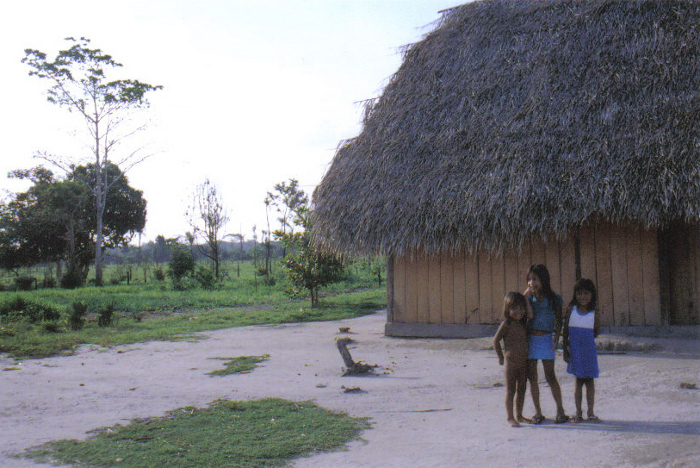
The Rio Guaporé Indigenous Territory is composed of the village sited at the Ricardo Franco Post, usually simply called the ‘Post,’ along with Baía da Coca, Baía das Onças, Baía Rica and the areas referred to as ‘Mata Verde’ and ‘Bairro.’ The Ricardo Franco village includes the Indigenous Post, school and infirmary. Surrounding the post are numerous houses headed by men from a variety of ethnic groups, while further away there are a few sites with settlements formed by extended families or young couples. The houses of the Wajuru and their families are located in the Ricardo Franco village. This is also where people visiting from other settlements in the IT can be found, Indians from other localities, especially Sagarana, and representatives from FUNAI, CIMI and other indigenist organizations. Baía da Coca is home to families headed by Makurap and Tupari men. Baía das Onças is recognized as Djeromitxí territory, along with Baía Rica, occupied by a single extended family. ‘Bairro’ and ‘Mata Verde’ are located between the post and Baía da Coca, while Baía Rica is situated between the post and Baía das Onças. ‘Bairro’ is home to an extended Tupari family and ‘Mata Verde’ to a Makurap area. Numerous smaller sites exist along the paths linking the denser settlements.
Today the residences close to the post follow the regional pattern: the houses normally have two bedrooms and a kitchen. They are made from timber with asbestos roofing and a dirt floor, when not cemented. However even at the post not all the houses are built in this fashion, some being made from wattle-and-daub and straw thatching.
All the houses situated close to the indigenous post have electricity, yet the more distant houses and those found in other villages have to make do without any supply. The main household appliance is without doubt the freezer, found in almost all the houses. Televisions are much rarer and the few houses with a set become a meeting place at night.
Each house has its own yard, which defines the space used by the family day-to-day – it separates the house from the forest growing around it. The women and their daughters clear the yard every day, ensuring that the contrast between forest and yard remains visible. There is no central clearing or a place where all the village members gather. The kitchen is like an extension of the yard and the place where visitors are welcomed. The yard also contains the livestock (chickens, ducks and pigs) and hunting dogs. A house, though, is only really independent when equipped with a pestle to mash manioc and produce chicha, an exclusively female activity. Those women owning a pestle become the meeting point for women living in the nearby houses.
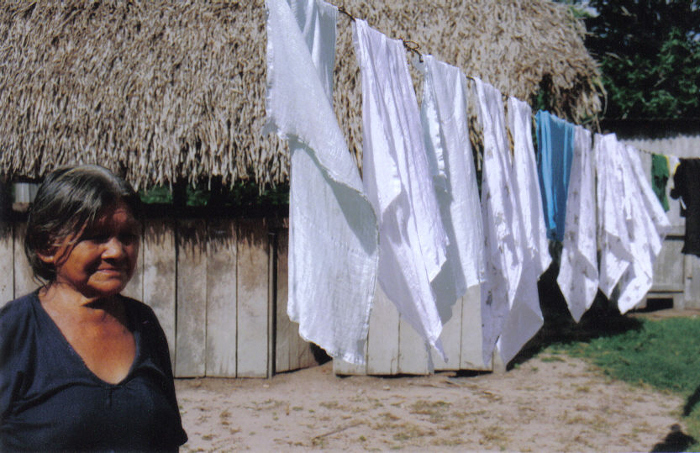
The houses are built in rows along the course of the river at right angles to its shore and are positioned fairly close to each other. This proximity is greater between houses in the same row than those in different rows. These rows, arranged along a horizontal axis, also have horizontal paths between them. These are wider and are used by people to walk to the post facilities or to drink chicha in another house. People take these paths when they wish to be seen. Between the rows of houses are other paths leading to the river, forest and swiddens, also used to visit other houses. These are more private since they pass through the yards. People use these paths only when they are closely related to the residents.
After marriage most women ended up moving to live in another part of the territory, frequently at some distance from their previous home. Men, in contrast, almost always remain at the same location. When they decide to move they only very rarely relocate to areas far from where their parents live, tending to go to a site inaugurated by their father. When a daughter marries, the parents have another place to go to drink chicha: indeed, the settlements can be mapped on the basis of the relations between groups of people who drink chicha together. The Wajuru say that the paths are kept cleared when neighbouring houses offer regular chicha festivals, but become grown over when the interval between festivals increases.
The houses normally shelter a nuclear family, or a husband and wife, unmarried daughters and recently married sons. At the post, the houses are usually home to a couple from different ethnic groups. This is where exogamy (marriage between people from different groups) becomes more visible and where – in the native expression – people are mixed. Despite this ‘mixture,’ it is easy to observe the cluster of houses occupied by Wajuru men (and those formed by other groups, such as the Kanoê, Djeromitxí and Makurap), displaying a form of spatial organization based on relations among extended families. This organization delimits the spaces of day-to-day living together, including the sharing of food and caring duties, such as giving advice to younger people, caring for sick relatives, displaying affection and laughing together.
Productive activities
The staple of the Wajuru diet is manioc, combined with fish and game animals. They also plant many varieties of maize, rice, beans, yam, peanuts and pineapple. The houses with extra income sources, such as the family allowance and pensions, are also able to obtain an influx of industrialized foods. Coffee, sugar, salt and oil, for example, are indispensable products in any home, along with soap.
The swiddens are located far from the houses, but their distribution follows the layout of the latter: the swiddens of brothers are cleared side-by-side. Husband and wife frequently go together to the swiddens and chicha festivals, and the couple can be seen as the main productive unit given their close cooperation in everyday activities (the wife produces chicha while the husband hunts and fishes]. Before marriage, the boy begins to cultivate his own swidden, separate from his father’s swidden but very often next to the latter. Later the swidden becomes perceived as the couple’s space and the wife begins to work there and appropriate the grown produce.
Women and girls are responsible for cleaning the house and providing water and firewood, as well as collecting wild fruits. Manioc is cultivated exclusively by women: they plant manioc stalks, harvest the tubers and carry the swidden produce home. The swiddens are cleared in groups. They weave maricos (bags of various sizes made from tucum palm fibres) and decorations like necklaces, bracelets and ear pendants. Even when they live far from their parents, women also visit them and help their consanguine kin in swidden work. Women frequently take part in the chicha festivals in these villages, while their parents come to visit them to drink the chicha made by their daughters. Hence parents-in-law commonly visit their sons-in-law, though the opposite seldom occurs.
Other kinds of weaving and wickerwork are male activities: they make roof tiles, mats and fans. Boys also carve the small bench used exclusively by shamans (normally their grandfather). Men clear the swidden, burn the felled wood, open clearings to build new houses, hunt and fish. Hunting trips, which usually employ guns rather than bows and arrows, may be in pairs (brothers, young couples or even brothers-in-law) and may take one, two or three nights at most. These activities contrast with the once traditional hunting trips in the forest involving much larger groups and lasted more than two weeks – expeditions still undertaken in Baía das Onças. Hunting screens are also commonly used: the hunter travels alone to a hide, known as his ‘waiting spot,’ located up in a tree, where he spends the night waiting.
The forest has many owners: whether spirits, the owners of animals, always dangerous, or the forest’s main predator, the jaguar. Hunting activity is conceived as a form of theft. The Wajuru say that the hunters steal game from the jaguar. However rules of etiquette exist concerning this theft. Firstly, there are territories used by particular hunters rather than others. Secondly the hunt produce cannot exceed the quantity needed to feed the closest kin since allowing meat (and fish) to spoil is widely condemned. Finally embark on hunting trips in silence, saying nothing about the activity they are about to engage in, though their wives already know. This silence continues until their return when the food begins to be prepared for cooking. Likewise no remarks or descriptions are made concerning the hunt and events in the forest or on the river. Whoever returns from the swidden (men or women), hunting trips or fishing trips (men) heads directly for their house without speaking to anyone. The same applies when they leave the village. In the case of men, the return from the forest is invariably accompanied by bathing in the nearby river or stream.
Hunting is primarily carried out by young men without children or with small infants. As they grow up, boys begin to hunt in the place of their father, who for his part has more time to take part in chicha festivals. Even though the main hunters of the extended family are younger men, the hunt produce is given to women. Grandmothers ‘head’ the houses and distribute the meat to other related houses.
The mother-in-law/daughter-in-law is largely mediated by the distribution of game and fish, reciprocated by the work of producing fermented drink. Since it is the female head of the family who organizes the chicha production, carried out within the space of the house, it is the daughter-in-law’s repeated work that allows her to achieve a degree of independence from her mother-in-law and become the head of her own house. Additionally, chicha production also involves the husband’s sister and brother’s wife whose role is similar from the viewpoint of the mother/daughter-in-law relation. They also provide their labour, including the same production tasks, and are the main collaborators among themselves.
All these activities – swidden clearing, hunting and fishing (in the case of men) and domestic work, food cooking, swidden cultivation and chicha production (in the case of women) – are conceived as work.
Conception, blood and patrifiliation
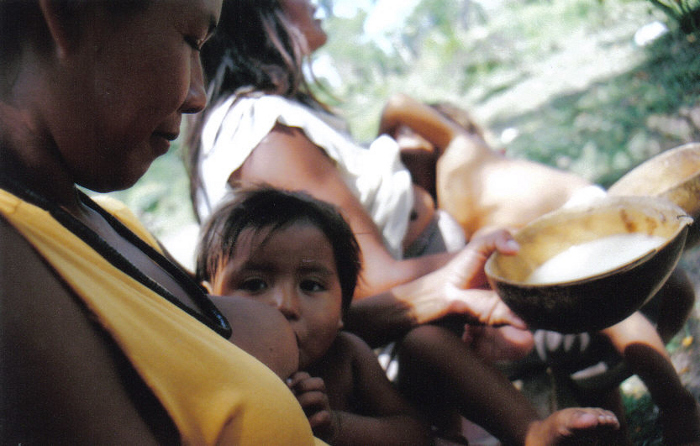
The Wajuru do not conceive the sexual act as the only way for a woman to become pregnant. On the contrary, shamans are also imputed with the capacity to inseminate, associated most of the time with the animal component of the person. Shamans are said to bring souls from the sky and place them in women’s bellies. They can also manipulate a woman’s reproductive capacity, either to help her become pregnant, or to avoid pregnancy through the use of forest remedies.
The local theory of gestation also suggests the female womb is unable to generate a baby adequately by itself. People claim that the male activity is indispensable on this point. During pregnancy the woman receives her husband’s blood which is inserted through repeated sexual relations. If this does not happen, the baby’s body faces serious risks to its health and integrity. In addition, the mother’s behaviour during pregnancy can influence the baby’s constitution, very often being responsible for a physical or social trait that will accompany the person throughout life.
After the birth, the mother and father must respect a number of precautions to ensure that the newborn is not exposed to the dangers of the world of spirits, especially the risk of its soul being stolen. The baby’s body is soft but gradually becomes firm as the parents feed the child and observe their period of reclusion. The process is conceived as a decline in the relations with the virtual plane as the baby is protected against attacks from spirits, the owners of game animals. It should be stressed, though, that these dangers can irrupt at any moment during the person’s life.
The precautions influencing the constitution of the child’s body vary according to the parent’s gender: women follow dietary restrictions (since they are the ones who breastfeed their children) while men adhere to restrictions on their hunting activities. Women avoid consuming the meat of animal game, birds and catfish (which can only be consumed after a shamanic curing ritual), while men avoid killing any animal predators. To protect the baby’s life, the couple avoid having sex for about a month until the woman produces her first chicha after the delivery, the ‘handwashing-chicha.’ This moment is seen as the end of the flow of blood between the mother and baby: the chicha ‘washes’ the child’s hands after the blood has gone. Though taking part in the chicha festivals, parents with newborn children do not dance.
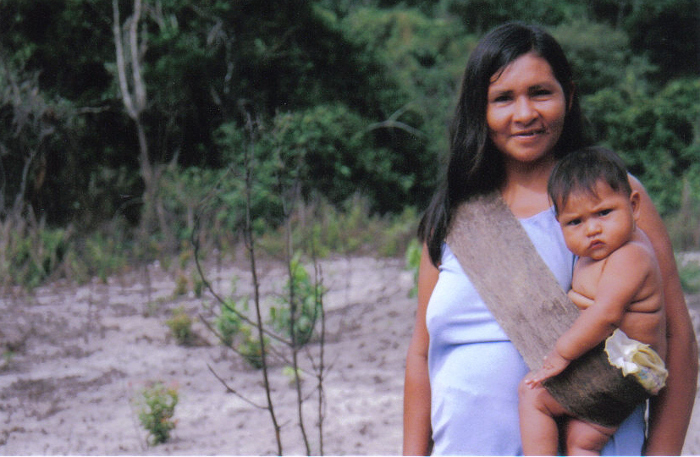
Blood is thought to be sign of substance/kinship relations and female reproduction is deemed to introduce a discontinuity into these relations. This is why the Wajuru say that women are responsible for augmenting the kin and/or blood of others, since her children will belong to a different ethnic group to herself. In the opposite direction, male reproduction is responsible for the continuity of blood connections. People say that children are decided by the father since it is the father who has the child. Patrifiliation is thus to a large extent mediated by the blood connections between the father and his children, supposedly attested by the fact that the child carries the father’s physical traits from gestation.
It should be observed that the reproduction of a male-line substance/blood group can, in some cases, occur without the children and father living together. In this case, the kinship network of the children is extended via their adoptive father to include those who raise them. Even so, an individual is still said to belong to the ethnic group of his or her genitor and must take into account the kinship networks involved.
In the Wajuru case, ethnic affiliation does not depend on any extensive temporal depth and is not established via descent relations between mythical ancestors and contemporary humans. In the Wajuru narratives in the discoverer demiurges there is no reference to the emergence of descendents or the consolidation of a kin group. Hence there is no common trajectory to the group that can be traced back to its origin. The Wajuru ‘peoples’ are organized on the basis of an ancient territoriality and ways of life associated with it, while the depth of genealogical memory is fairly shallow.
In Wajuru social organization, ethnic recruitment centres on the notion of patrifiliation. This concept sustains the idiom of preferential marriages outside the ethnic group.
Marriage and friendship
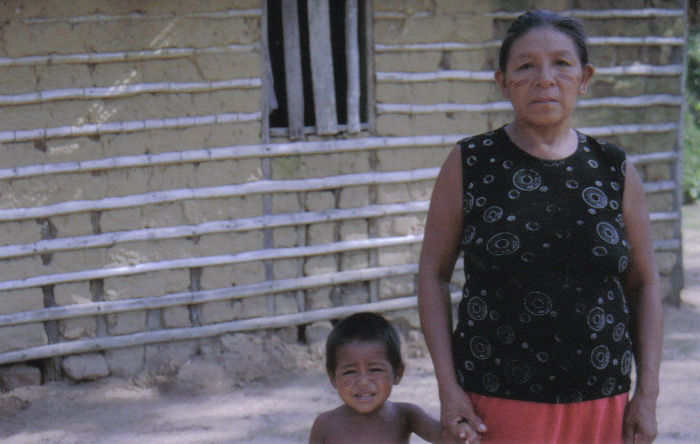
Marriages can take place when a daughter is handed over to the domestic group of her future husband, or when the woman is kidnapped and the young couple flees. Although there is no formal ceremony delineating the new status of the partners, as soon as the girl enters her new domestic group she must produce her first chicha. This is when the men from the two groups will meet to drink together. In addition there is a clear tendency for boys not to marry very young before they are properly trained – that is, when they do not yet possess the know-how needed for hunting and agricultural work.
Nowadays when a mixture of peoples is highlighted, ethnic identity – transmitted via the paternal line –establishes the necessary distance for exchanging women. Relatives on the paternal side are considered one’s own kin while relatives on the maternal side are considered other kin. Preferential marriage takes place with these other kin. This division in the field of kinship between own and other kin may be modified according to other forms of calculating distance in cases where marriage with kin from the paternal side is considered. Although marriage between a Wajuru man and woman is logically possible, they do not actually occur. The marriage that may preferentially occur is between the children of cousins (one or more generations distant) as long as there has been an exogamic marriage previously (between a man and woman from different ethnic groups).
A prescribed category exist for spouses, called oguaikup in Wajuru, or virá in Djeromitxí, which is the term most frequently used by the Wajuru themselves. These categories mark on one hand the preference for marriage and, on the other, formal friendship between people of the same gender. For this reason virás are also called friends/comrades. Although the ‘preferred’ marriage is with a distant generation, some marriages occur between more proximate generations.
The relationship between same-sex virás/comrades, more commonly found among men, oscillates between extreme playfulness and mutual respect and protection. At the same time as formalizing positions, the behaviour between virás expresses the informality that can occur between those who are very close. From the Wajuru viewpoint, the virás play about so much with each other that they cease to act as kin, who relate in a restrained and extremely respectful form. Virás can appropriate and use each other’s objects freely, just as a virá is permitted to defend the other from threats by all means necessary. In childhood they live continually in each other’s company, hunting, fishing, eating, swimming and playing together. After marriage, they help each other in swidden work and are always present at the chicha festivals organized by the other partner.
Marriages between virás that are not actualized may transform the same-sex spouses of the two couples into comrades, which, if they live close by, may include mutual help and company in daily activities. At the same time, marriages that do take place cancel the virá behaviour of playfulness and extreme closeness between effective brothers-in-law. In this sense, the virá positions are more like a potentiality, expressing their diverse possibilities for becoming actualized.
Chicha festivals
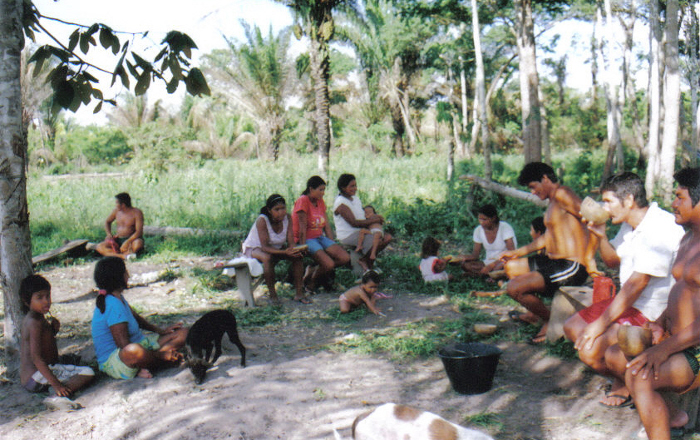
The chichadas, festivals involving copious amounts of fermented drink, condense the main relations and events of the Wajuru village and cosmological life. They occur very frequently, two or three times a week, uniting people from a wide variety of ethnic groups. Chicha, or tuerô in the Wajuru language, more specifically tuerô jati, ‘fierce, sour, fermented chicha,’ is usually made from manioc, though people say that in the past chicha was very often made from maize, yam or peanuts. In some houses, drinks made from these ingredients have a special value: they are chichas that relate back to the era of the malocas. Their consumption is much more domestic than chicha produced from manioc, which is consumed in large meetings by everyone from very small children to the oldest.
Manioc is conceived as the product of a series of transformations of the body of a mythological being. In this sense, planting manioc stalks can be translated as burying people. For the Wajuru, chicha is shrouded in mystery. The mastigated pulp produced by the women makes the manioc soft. The only restriction imposed on this activity is when a woman discovers she is menstruating, since any man who consumes the chicha afterwards runs the risk of becoming ‘panema’ (becoming weak and unlucky in hunting). Fermentation takes place inside the cocho (a carved wooden container suspended on forked stakes), very often associated with the body of a boa constrictor. On the other hand, production and consumption of the drink are attributes of other beings who do not present a human form to those without shamanic vision (the shamans use tobacco and rapé powder to obtain this vision). For the Wajuru, these traits are proof of the humanity of these beings: the shamans say that the sky and the depths of the rivers are filled with people! There everything is just like here: swiddens, malocas and chicha.
The degree of fermentation of the chicha defines its range within the community: the more fierce/sour the drink is, the more people will gather around it, while the more sweet/mild, the more domestic its consumption. The ideal is for all chicha to become sour, that is, inebriating, and women work intensely to try to ensure this happens. Produced in the houses, chicha is consumed collectively on two occasions: as payment for collective work undertaken for the benefit of a particular domestic group (clearing, burning, planting or weeding of swiddens, paths and yards, fixing of the roof), or as a gift during festivals: birthdays of younger people, marriages and special dates (Christmas, New Year, etc.). The latter festivals must include dancing (to the sound of forró and Makurap music sung by the elders), but in the chicha festivals for collective work this relation is indirect. In both cases nobody will attend if the owner of the chicha does not invite them to the festival at their house. Guests are also offered food by the group organizing the work or festival.
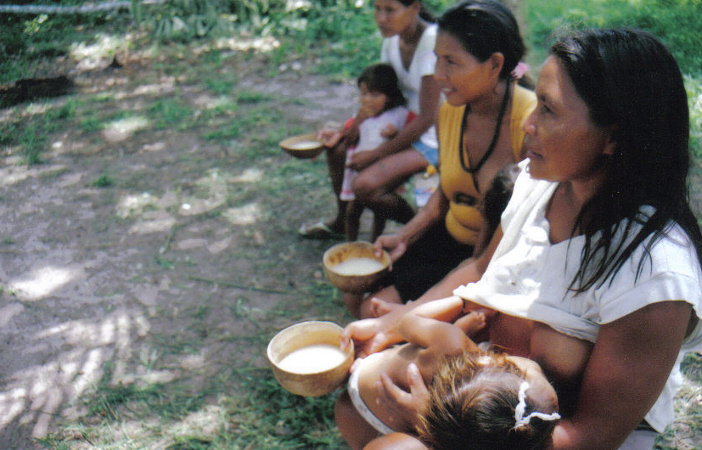
There is a constant exchange of the roles of organizer/worker and producer/consumer, and in this chicha emerges as a kind of gift through which people communicate and meet, though always occupying a different position. As the circulation of the task of organizing the festivals makes clear, older men are the most adept at performing this function of catalyzing social life. Their unmarried daughters help their mothers to prepare the drink, sons-in-law or sons help build the houses, renew the roofs, clear and look after the swiddens and so on. But the most important element is a hollow trunk filled with chicha, since this has the power to assemble many people for the work.
Sexual metaphors are omnipresent in the chicha festivals and playfulness (between talking and dancing) is the typical relational mode on such occasions, both because it is here that the virás/oguaikup (comrades) have the chance to express their proximity, and because the context enables a kind of relaxation between some relatives, especially kin of opposite sexes.
Men usually rely on support from other kinship relations, namely those established via their female ascendants. They call on their manos to drink with them, a form of address used especially between those considered brothers from different ethnic groups. Likewise the weak presence of affinal relations in domestic sociality, from the male point of view, finds its counterpoint in the chicha festivals where men from the house interact intensely and publicly with their same-sex affines. During these occasions women are responsible for calming the relations between men, since they are the ones who enable communication. Women, for their part, meet their own kin on these occasions and have the chance to relax and drink with them.
Notes on the sources
In 1948 Claude Lévi-Strauss pointed out that the history of the indigenous peoples of the right bank of the middle Guaporé river was one of the least known in Brazil. Nonetheless, long after the publication of the Handbook of South American Indians (1948) in which the author provided a brief description of the area (‘Tribes of the right bank of the Guaporé River’) and the numerous works by Franz Caspar originally published in the 1950s on the Tupari, extremely little was written about this region.
There are a few exceptions, though, such as the work of Denise Maldi (1991) on the ‘Marico Complex.’ This important text, commissioned by the Goeldi Museum, is the result of the researcher’s fieldwork in which she outlines a broad panorama, emphasizing the cultural elements shared by these peoples and tracing an intercultural complex. For their part, the works of Betty Mindlin (1995, 1997 and 2001), compiling mythic narratives, appear to be the only examples of recent production on these peoples. In addition the author also produced a text on Tupari mythology (Mindlin 1993).
During the interim between the works of Caspar and the later works of Maldi and Mindlin two important documents were published. One contains a brief compilation of information and sources undertaken by Price (1981) in response to the Polonoroeste Project set to affect indigenous populations in Rondônia state. The other is the report for amplification of the Rio Guaporé Indigenous territory, produced under the coordination of anthropologist Maria Auxiliadora de Sá Leão (FUNAI 1985), which contains valuable information on the activities of the SPI (Indian Protection Service) in the region and the forms of social organization of these peoples in the context of transformations in their relations in the area of the Ricardo Franco Indigenous Post, later transformed into the Rio Guaporé IT.
In 2009, Nicole Soares Pinto presented her MA dissertation on the Postgraduate Program in Social Anthropology at the Federal University of Paraná, entitled ‘Do poder do sangue e da chicha: os Wajuru do Guaporé (Rondônia).’ This work provide an ethnography of Wajuru social dynamics, focusing especially on kinship and social organization.
Sources of information
- DONNER, Beker. 1955. “First report on a field trip to the Guaporé region (Pacaas Novos)”. In: Anais do XXXI Congresso Internacional de Americanistas. São Paulo: Anhembi
- CASPAR, Franz. 1953a. Tupari: entre os índios, nas florestas brasileiras. São Paulo: Melhoramentos.
- -----------------------1953b. “Some sex beliefs and practices of tupari indian (Western Brazil)”. In: Rev. Do Museu Paulista, São Paulo, Nova Série, V. III, pp. 201-248.
- -----------------------1955a. “A expedição de P. H. Fawcett a tribo dos Maxubi em 1914”. Anais do XXXI Congresso Internacional de Americanistas. São Paulo: Anhembi, vol. 1.
- -----------------------1955 b. “Um caso de desenvolvimento anormal da personalidade observado entre os Tupari”. In: Anais do XXXI Congresso Internacional de Americanistas. São Paulo: Anhembi, pp.121-126.
- -----------------------1956/1958. “Puberty Rites Among The Tupari Indians”. In: Ver. Do Museu Paulista. São Paulo, Nova Série, vol. X, pp. 141-154.
- -----------------------1976 [1957] “A aculturação dos Tuparis”. In: Egon Shaden (org.) Leituras de Etnologia Brasileira. São Paulo: Companhia Editorial Nacional.
- FUNAI .1985. Relatório Antropológico de demarcação da Terra Indígena Rio Guaporé (coordenação de Maria Auxiliadora de Sá Leão).
- LÉVI-STRAUSS, Claude. 1948. “Tribes of the Right Bank of the Guaporé River”. In: STEWARD, Julian (org.) Handbook of South American Indians. Washington: Smithsonian Institution, Bulletin 143, vol. 3, pp: 371-379.
- MALDI, Denise . 1991. “O complexo cultural do marico: sociedades indígenas do rio Branco, Colorado e Mequens, afluentes do médio Guaporé”. In: Boletim do Museu Paraense Emílio Goeldi (Antropologia). vol. 7, nº 2, pp. 209-269.
- MINDLIN, Betty. 1993. Tuparis e tarupás — Narrativas dos índios Tuparis de Rondônia. São Paulo: Brasiliense/Edusp/Iamá (Instituto de Antropologia e Meio Ambiente).
- ----------------------1995. Antologia de mitos dos povos Ajuru, Arara, Arikapu, Aruá, Kanoe, Jabuti e Makurap. São Paulo: Iamá, 67 p
- ---------------------e narradores indígenas. 1997. Moqueca de maridos: mitos eróticos. Rio de Janeiro: Record; Rosa dos Tempos.
- ---------------------2001. Terra grávida. Rio de Janeiro: Record; Rosa dos Tempos.
- ---------------------PRICE, David. 1981. “The indians of southern Rondônia”. In: Cultural Survival, Inc., In the path of Polonoroeste: endangered peoples of western Brazil. Occasional Paper. Cambridge, pp. 34-37.
- SNETHLAGE, Emil H. 1935. Indianer kulturen aus dem grenzgebiet Bolivien - Brasilien. Ergebnisse der forschungsreise 1933 - 1934. Führer durch Ausstellung im staatlichen Museum for volkerkunde, Berlin vom 15August bis 15. november 1935. Berlim.
- SOARES-PINTO, Nicole. 2009. Do poder do sangue e da chicha: os Wajuru do Guaporé (Rondônia). Dissertação de mestrado apresentada ao Programa de Pós Graduação em Antropologia Social da Universidade Federal do Paraná.
- WAWZYNIAK, João Valentin. 2000. Do Barracão à Casa: Uma etnografia das transformações nas formas de apropriação, gestão e transmissão dos recursos naturais por seringueiros do rio Ouro Preto – RO. Dissertação de Mestrado apresentada ao Programa de Pós Graduação em Antropologia Social da Universidade Federal do Paraná.